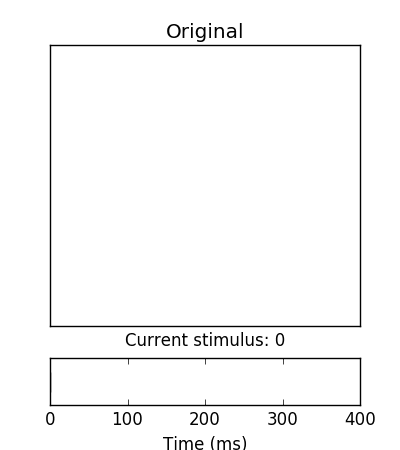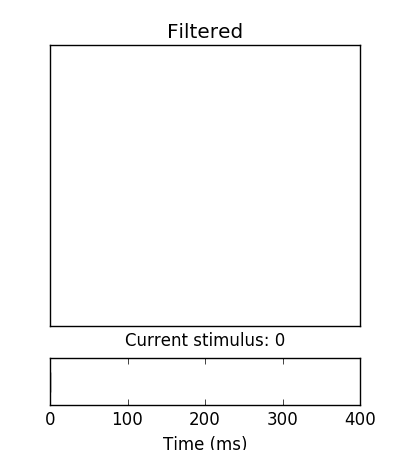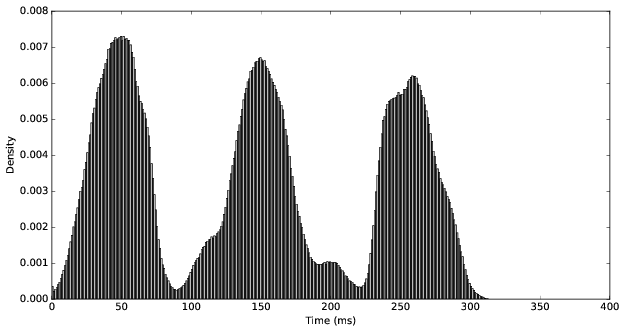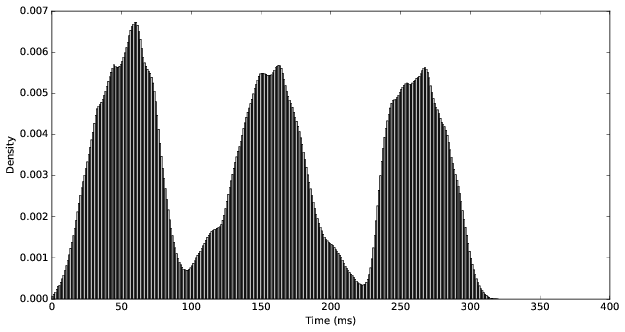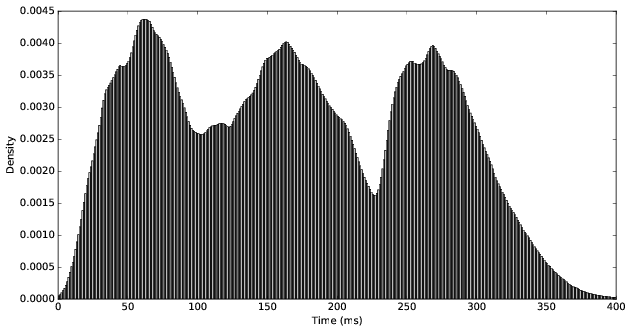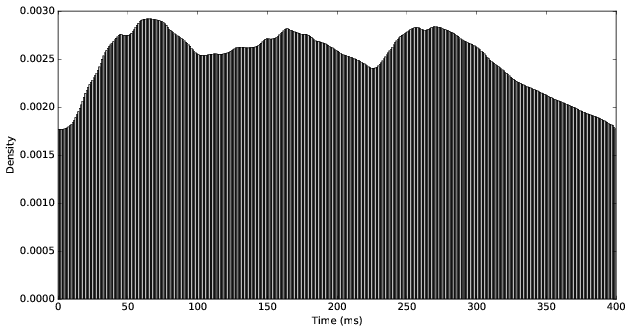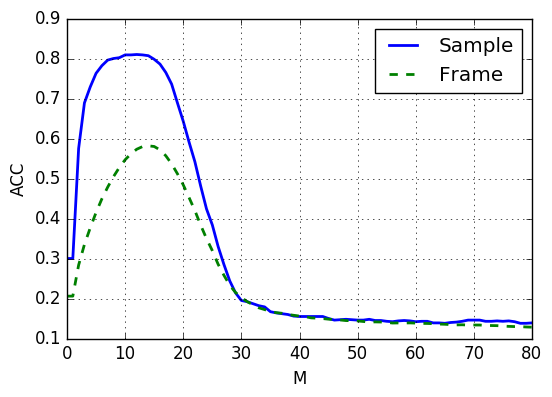Event-based image classification with a (stateless) frame-based classifier
Part of the 2016 Telluride Neuromorphic Cognition Engineering Workshop.
Summary
A dynamic vision sensor (DVS) is a neuromorphic sensor that produces spikes asynchronously as changes in light are detected in a scene. This allows the DVS to run in an event-driven manner at very low power, producing no output if no changes are detected. In order to detect a non-moving stimulus, such as a static image, some motion in the sensor is required, analogous to how our eyes move to detect a scene.
This project aims to develop a framework that will enable a frame-based classifier implemented on TrueNorth to recognized static images presented to a DVS. This provides a complete neuromorphic solution to image recognition, leveraging current spike-based classification algorithms. Results are obtained using the N-MNIST dataset, described here and available for download here.
Motivation
The asynchronous nature of the DVS is problematic for many current machine learning algorithms that operate in a stateless frame-based manner in which the entire stimulus is present. For example, k-nearest neighbor (kNN), support vector machine (SVM), and feedforward neural network classifiers operate on a complete stimulus and produce a classification decision or score in a single time step (ignoring the internal computation bounds for classification). Subsequent classifications are independent of each other.
Spike events are continuously produced by the DVS when there is some motion between the DVS and the stimulus. Because of this, only some of the spikes induced by the stimulus will be present within a window of length T, assuming T is less than the duration of the entire stimulus. As the size of this window approaches 0, the number of stimulus-induced spikes within the window decreases. In practice, T may correspond to the clock period of a neuromorphic architecture, such as TrueNorth.
There are a variety of stateless frame-based classifiers that run on TrueNorth, able to make a classification decision in a single time step (1 millisecond at the normal clock rate), such as the probabilistic feedforward network and convolutional network with trinary weights. The ability to utilize current frame-based classifiers on TrueNorth for images presented to the DVS would provide a complete neuromorphic solution to image classification.
Since it takes time for the stimulus to move and spikes to be generated, some state must be maintained. It would be desirable to separate the stateful properties required to continuously classify a moving stimulus presented to the DVS from the stateless properties of the classifier. Stateless frame-based classifiers are conceptually simple compared to their stateful counterparts (e.g., recurrent networks). This would also allow the individual components to be swapped out based on the task. For example, a stateless classifier trained to recognize digits could be used for digits that move both quickly and slowly. Additionally, a classification decision could be made continuously at every time step despite the raw input being relatively sparse.
Challenge
Although a frame-based classifier relies on being able to view an entire stimulus, DVS spikes induced by moving stimulus are probably not jointly present at any time. To enable a frame-based classifier, which operates in a single time step, to classify the continuous stream of spikes, some memory of the stimulus must be maintained. There are actually two conflicting requirements for the memory filter: remember and forget. In particular, the memory filter must:
- Integrate spikes from a single stimulus long enough for the stimulus to be recognized.
- Forget the spikes quick enough to avoid corrupting subsequent stimuli.
This presents a challenge for the memory filter. The two conflicting requirements also create an opportunity to derive the optimal parameters for a memory filter, given the statistics of the stimuli and intervals.
Solution
A population of leaky integrate and fire (LIF) neurons acts as a short term memory, filtering the spikes from the DVS before passing them to the classifier. The memory neurons remember when a spike occurs by spiking for a short period afterwards. The duration of postsynaptic spiking activity is controlled by a single parameter, M. This has the effect of multiplying the spike probability, given the stimulus is present. Specifically, the memory filter transforms the spike probability by
P(spike | stimulus) -> M * P(spike | stimulus)
where M is the memory duration of the filter. This behavior is achieved by setting TrueNorth neuron parameters:
s = M
alpha = 1
gamma = 1
The memory neurons are arranged in a single layer between the DVS and the classifier, with one-to-one synaptic connections between the DVS, memory layer, and the first layer of the classifier.
As an example, consider the spikes induced by a single stimulus (the digit "0", followed by a 100 ms interval), shown below on the left. Binned into 1 ms windows, corresponding the clock period of TrueNorth, relatively few spikes are ever jointly observed. After a filter is applied with M = 10, the spikes from the stimulus persist long enough for the entire image to be viewed at several time steps, shown on the right.
As M increases, the spike probability saturates the duration of the stimulus and begins to corrupt the subsequent interval when no stimulus is present (and eventually, when the next stimulus appears). This effect is confirmed by the spike density over time, begining at time 0 when the stimulus is first presented. Over 1000 samples, the original spike density is given by:
After a memory filter with M = 5 is applied the density is slightly smoothed:
A memory filter with M = 10 further smooths the trimodal distribution, pushing some of the mass to the 100 ms post-stimulus interval:
At M = 20, the spiking probability begins to saturate the duration of the stimulus and overflow into the post-stimulus interval:
Since the memory filter has a multiplicative effect on the spike probability, one can hypothesize that optimal performance will occur somewhere around M = 1 / p, where p is the maximum neuron spiking probability while the stimulus is present. Assuming the spikes are uniformly distributed from time 0 to D, where D is the duration of the stimulus, the expected number of spikes from the most active neuron is p * D. After the filter with M = 1 / p is applied, the expected number of spikes increases to 1/p * p * D = D, i.e., a spike on every time step. Increasing beyond this bound will cause the most active neuron to persist after the stimulus is removed. Of course, some of these assumptions are violated: stimulus neurons don't all spike with probability p, and these are likely not uniformly distributed over time. This can be seen in the spike density plots above, which reflect the way in which the N-MNIST dataset was collected, namely by three successive saccades.
The average maximum spiking probability of 1000 randomly-selected samples is 0.113, i.e., the most active neuron in each sample spikes on about 1 out of 10 time steps. Taking the inverse, 1 / 0.113 = 8.838..., an optimal value of M is about 9.
Experimental results:
Results are obtained using training and testing sets of 1000 samples each. A 2-layer pyramid-shaped probabilistic network is trained using the spiking probability normalized by the maximum spiking probability. Synapse weights are randomly chosen from {-2, -1, 1, 2} such that the total input to any neuron is balanced around 0. Connection probabilities are determined by adaptive moment estimation (Adam) using 0.5 dropout in the last layer and 100 epochs. The resulting network is deployed to TrueNorth, occupying a total of 5 cores. The memory filter occupies 4 cores, for a total of 9 cores.
Classification accuracies are first determined for the single frame (spiking probability) samples. The spiking probabilities are classified using the high-precision network. The single-frame spiking probabilities are then convert to a single frame of spikes to determine the classification accuracy on the low-precision network.
| Train | Test | |
|---|---|---|
| Proba | 0.960 | 0.874 |
| Spike | 0.865 | 0.744 |
Continuous classification is determined using the set of 1000 samples with 100 ms intervals between stimuli. Each sample is approximately 300 ms, for a total of ~400k frames. This corresponds to a runtime of about 400 seconds, or 6.6 minutes, on an NS1e. Frame-level classification accuracy is determined by a maximum vote among the response neurons for the 10 classes. Sample-level classification accuracy is determined by a weighted max vote in which the response neurons from the entire duration of the stimulus are weighted by the number of input spikes. This places greater weight on the responses recorded during greater motion. Both accuracies are determined for values of M in [0, 80], where M = 1 causes the memory filter to produce an exact copy of the original input spikes.
The highest sample-level accuracy is achieved at M = 12. Due to the 100 ms intervals between stimuli, M can be slightly increased beyond the optimal value predicted above before the subsequent stimuli are corrupted.
| Original | Memory | |
|---|---|---|
| Frame | 0.206 | 0.573 |
| Sample | 0.300 | 0.810 |
Steps to reproduce
Coming soon...
Requirements
tensorflow
pytruenorth
Run the main script:
$ python main.py
Future work
- Differentiate between on/off spikes (e.g., with two concurrent pipelines)
- Apply the memory filter to response neurons for better segmentation
- Add receptive fields to memory neurons to reduce noise and strengthen blobs
- Responsive memory filter with, e.g., exponential decay. Integrate until the stimulus disappears, then reset abruptly
